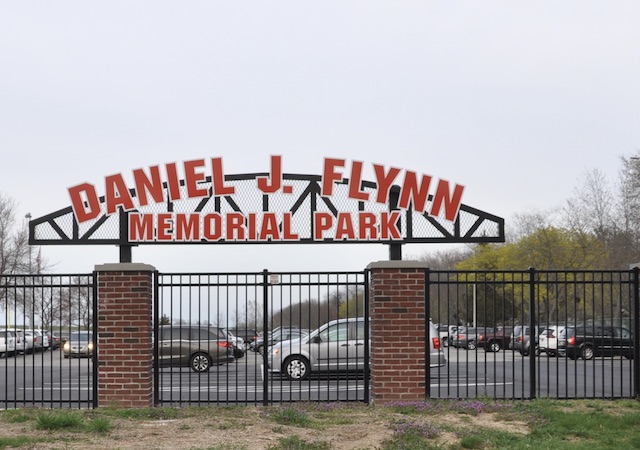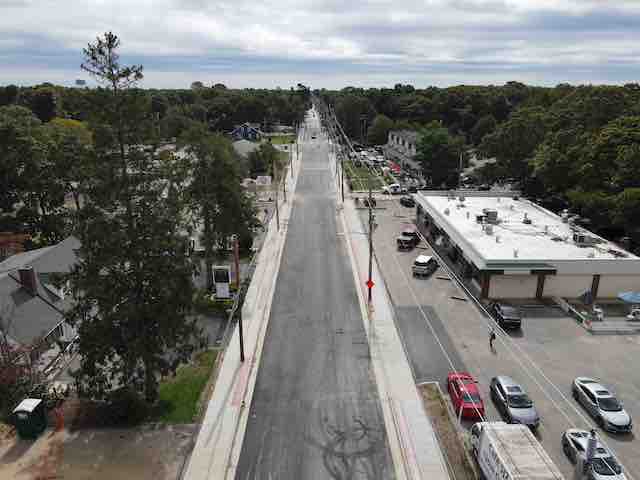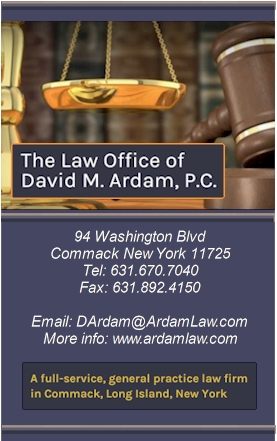News Of Long Ago - "Judge John Lawrence Smith's Daughters Tie The Matrimonial Knot"
 Monday, October 14, 2013 at 7:56PM
Monday, October 14, 2013 at 7:56PM News of Long Ago by Bradley Harris, Smithtown Historian
(Last week I wrote about the five daughters of Judge John Lawrence Smith and the relationship they had with their father as children and young adults. This article takes a look at the lives of the five women and their choice of marriage mates as they left the Judge’s homestead and created homesteads of their own.)
“Judge John Lawrence Smith’s daughters tie the matrimonial knot….”
When John Lawrence Smith died in 1889, he left the homestead and 200 acres of surrounding farmland in Smithtown Branch to his only son James Clinch Smith. He didn’t make any provisions for his daughters because by the time of the Judge’s death, all of his daughters were happily married to successful men who were comfortably wealthy. Only James had yet to find a mate and the Judge decided to give his son his legacy. But in reality, the Judge’s greatest legacy was not his wealth; rather it was to be found in his five daughters and their husbands and the children they produced. They were the Judge’s legacy to the people of Smithtown and what an amazing gift they proved to be.
The Judge’s oldest daughter, Cornelia was the first daughter to be married. In 1874, when Cornelia was 28, she married her mother’s 26 year old cousin, Prescott Hall Butler. As a law student, Prescott Butler clerked for Judge Smith in his home in Smithtown Branch and this is where Cornelia and Prescott became acquainted. Following their June marriage in the St. James Episcopal Church, the Butlers lived in New York City where Prescott’s parents owned an apartment building. Prescott joined his father’s law firm – Evarts, Southmayd, and Beman. Apparently, Prescott Butler did very well as a lawyer since in 1879 he had the money to ask his Harvard classmate Charles McKIm to design a summer house for him in St. James. The house, known as ‘Bytheharbor,’ was McKim’s first commission as an architect and was subsequently built on the crest of a hill overlooking St. James Harbor. Entrance gates and a winding driveway led directly to the house that was just off the northeast corner of Moriches Road and Cordwood Path. To bring water to the house, Prescott Butler had a 150-foot tall windmill constructed on the harbor and the windmill pumped fresh water up the hill to the house.
The Butlers spent their summers in St. James and their children, Lawrence (b.1875), Charles (b.1876), and Susan (b.1879) all grew up in this house by the harbor. Eventually, the Butlers would own “more than 800 contiguous acres of land in this area, including some sixty-eight acres on Fifty Acre Road which their sons Charles and Lawrence and daughter Susan Huntington were to inherit.” That inheritance came quicker than anyone anticipated. Just before the turn of the twentieth century, Prescott Butler had a fine new stable built for his horses, swearing that he would never own an automobile. He never did since Prescott Butler died of cancer in 1901 at the age of 53. (Barbara Van Lieu, Head-of-the-Harbor, A Journey Through Time, Main Road Books, Inc., Laurel, N.Y., 2005, pp. 36-37.)
Louise Nicoll Smith was the Judge’s second oldest daughter. Less than three months after Cornelia’s wedding, Louise, who was 25, married Frank Osborne on October 20, 1874. Like Cornelia, she married a 30 year old law student named Frank Sayre Osborne who was clerking in the Judge’s law office. They too were married in the St. James Episcopal Church. Frank Osborne took his young bride to Chicago where the Osbornes made their home. Frank and Louise had their first child, a girl named Sarah Nicoll Osborne, in August of 1875, and the children just kept arriving — Cornelia Stewart Osborne in 1877, Lawrence Woodhull Osborne in 1879, Harold Sayre Osborne in 1881, Ernest Baxter Osborne and Felix Sayre Osborne (twins) in 1883, and Farrand Sayre Osborne in 1887. Out of the seven children, only Cornelia Stewart Osborne returned to live in St. James. (Frederick Kinsman Smith, The Family of Richard Smith of Smithtown, L.I., The Smithtown Historical Society, Smithtown, L.I., N.Y., 1967, pp. 368-369.)
The Judge’s third daughter was Kate Annette Smith. Kate married an Episcopal priest, Reverend Joseph Bloomfield Wetherill, in Trinity Church in New York on January 2, 1879. Reverend Wetherill was serving as Rector of St. Ambrose Chapel and as an assistant to Reverend Morgan Dix who was the priest for Trinity Church. How Kate met Rev. Wetherill, and how long a courtship they had is not known. This marriage must have come as a shock to the Judge since Rev. Wetherill was 44 when he married 27 year old Kate, and the timing of the wedding, a day after New Year’s Day in 1879, suggests that they married simply and quietly without a big wedding. They lived in the city following their wedding. They had three children, two daughters and a son – Cornelia Stewart, b. in 1879; Isabella Macomb, b. in 1883; and Alexander Stewart, b. in 1885. Unfortunately for Kate, her 51 year old husband died in 1886, just a year and a half after the birth of his son Alexander. Kate Wetherill became a 34 year old widow with three small children. Following her husband’s death, Kate continued to live in the city with her children. (Frederick Kinsman Smith, op. cit., p. 369.)
The Judge’s youngest daughter was Bessie Springs Smith and she married the architect Stanford White. Stanford White became a partner in the architectural firm of McKim, Meade and White, and it was Charles McKim who introduced Stanford White to Cornelia’s younger sister, Bessie. “According to a family legend when McKim brought his young partner to visit the Smiths” at the Homestead, Bessie spied on White “through a keyhole” in the Judge’s office and is said to have “exclaimed, ‘Oh, I’d give anything to touch the hair on top of his head!’” Stanford White always cut his “blazing red hair” in a crew cut, and that combined with “his stagy handlebar mustache” made the architect “seem to radiate energy” and sparks. No wonder Bessie wanted to see if he would give off electricity. When he met her, White was “immediately attracted” by the 18 year old with “an ample figure,” but it took “three years of what Prescott Hall Butler characterized as ‘a protracted siege’ before she agreed to marry him.” (Stanford White’s New York, pp. 93-95.)
Bessie and Stanford White were married in a big wedding in Trinity Church in New York City on Feb. 7, 1884. Not long after the Whites returned from their six month European honeymoon, Bessie managed to convince her husband to “purchase Samuel Carmen’s farmhouse” that stood on the bluff overlooking St. James Harbor with a view of the harbor that Bessie had admired since childhood. Samuel Carmen’s farm was located on the south side of Cordwood Path and extended from Moriches Road down the hill to the harbor shoreline. The house was just across the road from Cornelia’s Bytheharbor home. Stanford White remodeled the farmhouse in 1891, 1899, and 1902, transforming the simple farmhouse into a large 15,000 square foot mansion with 13 gables and pebble-dashed exterior. This house, known as Box Hill because of all the boxwoods that Stanford White planted around the house, became the homestead for generations of the White family that inherited it. Bessie and Stanford had two children, Richard Grant (b.1884) who lived for eight months, and Lawrence Grant (b.1887) who lived to become an architect like his father and actually succeeded him in the firm of McKim, Mead and White. As her sister had chosen to do, Bessie remained in St. James following her husband’s death. (Barbara Van Lieu, op. cit., p. 36.)
Ella Batavia Smith, the Judge’s fourth daughter was actually his last daughter to be married. It was Ella who proved to be the most difficult child for the Judge to manage. According to family lore, Ella was in her teens when she became romantically involved with another of her mother’s cousins – Charles Clinch. The Judge was adamantly opposed to any relationship developing between Ella and Charles and “vigorously discouraged” any further contact between the two young people. “‘There has been enough of that stuff in this family,’ he reportedly said.” The ‘stuff’ he was referring to was the propensity of Smiths marrying their cousins and he didn’t like it, although he had allowed Cornelia to marry Prescott Hall Butler. But this union the Judge was determined to prevent. Since he was “unable or unwilling to send” Ella away “on the European tour traditional in such cases, he had a wooden cage built for her in the attic” of the Homestead. “After being imprisoned there and fed on bread and water for a month, young Ella became quite ill and was released.” (Barbara Van Lieu, op. cit., p. 52-53.)
Whether or not Ella was actually imprisoned in the attic of the Homestead, the fact remains that there is a wooden cage in the Homestead attic and it can be seen in the photograph accompanying this article. Charles Clinch became a career officer in the army and stayed away from Ella. Ella pined away for a number of years and then married Devereux Emmet on January 27, 1889. The wedding announcement shows that the Judge’s family was all present for Ella’s wedding – Cornelia, Louise, Kate, James, and Bessie were there. A wedding breakfast was held before the noon wedding that took place at “the residence of her father, ex-Judge J. Lawrence Smith, 537 Fifth-avenue.” The wedding ceremony was performed by the Rev. Dr. William S. Rainsford of St. George’s Episcopal Church and was “held in the presence of relatives and friends,” and the “bride’s four nieces“ – Cornelia Wetherill, Susie Butler, Eleanor Emmet, and Cornelia Osborne “attended the bride as she approached the floral altar.” The little girls “wore white dresses and pink wreaths, and carried baskets of pink flowers.” The reception for “500 guests” was held in the afternoon in the long parlor of the Judge’s home that had been “elaborately decorated with flowers.” When the wedding reception ended, the newly-weds departed on a three week honeymoon. Following the honeymoon, the Emmets planned to return to New York where they intended “to make their home at Cooperstown, where the groom has a large estate.” But these plans may have been cut short as Ella was drawn back to Smithtown when her father died. (“At Her Father’s Home, Miss Ella Batavia Smith Married to Devereux Emmet,” Proquest Historical Newspapers, The New York Times, Jan. 27, 1889, p. 9.)
Judge John Lawrence Smith passed away at his home in Smithtown Branch on March 17, 1889 less than two months after Ella’s wedding. He was 73. He had lived to see his five daughters grow into captivating young women who all found suitable mates and he had danced at their weddings. And he managed to live long enough to know some of his grandchildren who would become leaders of Smithtown long after he was gone. He died believing that his son James would succeed him as the patriarch of the family and become a leader in Smithtown. But that didn’t happen and it was the Judge’s daughters who became leaders in Smithtown.
More about the Smith sisters and their impact upon Smithtown next week….







